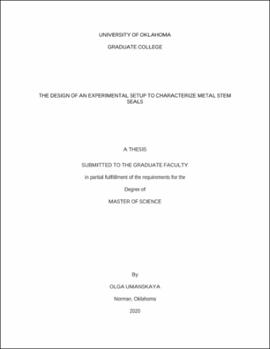| dc.description.abstract | Modernization has brought use of machinery in most industrial sectors to home use. Equipment used in the food industry, medical industry, construction, defense, aircraft, automotive, and energy industries utilizes the principle of the separation process of one media from another during rotation. Equipment used in the oil and gas industry sector uses machinery that requires sealing solutions for a safe and reliable process of handling hydrocarbons. The industry utilizes a variety of equipment where sealing mechanisms are employed, such as pumps, valves, manifolds, drilling, processing, and refining equipment. The equipment must securely separate the flow within and from the ambient environment. Lessons from the past have shown that the lack of attention to a sealing solution can lead to tragic outcomes.
To reduce these catastrophic failures and bring the application of oil and gas equipment into standardization, the industry developed standards with the help of the American Petroleum Institute (API). Any piece of equipment that falls under API standards must adhere to their specific requirements. This research was done with an overview of API 6A and API 17D standards, which cover the utilization and commissioning of Christmas trees and wellheads, where the latter can be a part of a blowout preventer assembly. Choke valves are the part of the equipment that falls under API 6A and API 17D standards. Depending on the manufacturer, some choke valves have a metal seal installed to control the leak of the contained fluid to the environment. The area of interest of this research was to design and build the testing equipment that can simulate real-life operating conditions of a choke valve to test the performance of the metal seal.
Seals are classified based on their static or dynamic applications. Seals can be designed and manufactured from a combination of materials depending on the application, environmental conditions, temperature, and pressure. To cater to different operating conditions, metal seals have different geometries that vary in complexity. Metal seals provide a wide array of sealing characteristics based upon these different geometries, materials, and coatings.
To properly test the performance of a metal seal, it needs to be exposed to the conditions that closely simulate the environment and operating conditions at which this seal will be utilized. The seal needs to be subjected to a cyclic application in a controlled laboratory environment and proves that it is reliable and safe for the application in the field. The unique testing setup should be designed and manufactured to imitate the custom environmental conditions. Since the testing setup equipment is a custom-made item, it must incorporate available components and specially manufactured components into one system.
This Thesis is focused on the following research questions:
1. How to organize the design and fabrication process of the metal stem seal testing equipment?
2. How to design and manufacture a unique testing setup to test metal seals?
The setup was developed to facilitate the design and manufacturing process. This thesis is organized to present several phases and details of the important steps of each phase. The phases included the process of gathering the ideas of the testing design, finalizing the concept, phase of development and execution of the design process, and validating the setup through testing and experimentation. The design portion of this research included a detailed analysis of the equipment and systems that were created to serve the goals of this research.
Testing of the metal seal performance under various pressure conditions, temperature, and different torque application showed the limitations and recommendations for future research. | en_US |
